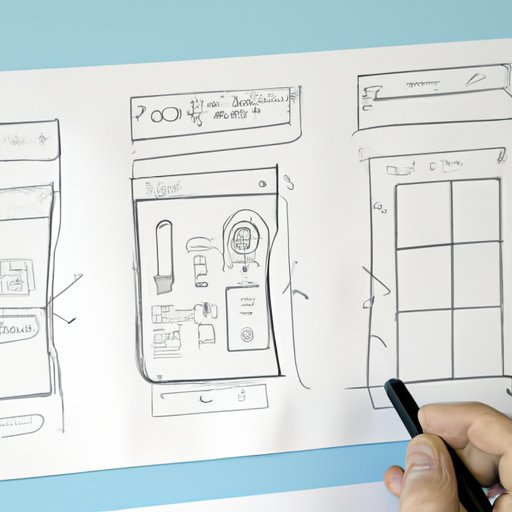Introduction
In the modern world, apps have become an integral part of our lives. Whether it’s for entertainment, productivity, or communication, apps provide us with convenience and access to information and services in ways that weren’t possible before. As such, many people are now interested in creating their own apps. But what does it take to create a successful app? This article will explore the steps involved in creating your own app, from researching the app development process to launching your app.
Researching the App Development Process
The first step in creating your own app is to understand the app development process. This includes understanding the different phases of development, learning about software development tools and technologies, and investigating app stores and platforms. It’s important to gain an understanding of the various aspects of the app development process so that you can plan accordingly and create an effective app.

Understanding the Different Phases of Development
App development typically involves several phases, including concept design, prototyping, development, testing, and launch. During the concept design phase, you will determine the purpose of your app and decide how it should look and function. During the prototyping phase, you will create a prototype of your app to test its functionality and get feedback from users. During the development phase, you will develop the frontend and backend of the app. During the testing phase, you will perform tests and debug any issues. Finally, during the launch phase, you will make your app available on app stores and platform.
Learning About Software Development Tools and Technologies
Software development tools and technologies are essential for creating an app. Depending on the type of app you are creating, you will need to learn about different programming languages, frameworks, databases, and other tools. You might also need to use APIs and SDKs to integrate your app with other services and platforms. It’s important to understand the various software development tools and technologies so that you can select the right ones for your app.
Investigating App Stores and Platforms
Once you have a basic understanding of the app development process and the necessary tools and technologies, you should investigate app stores and platforms. Depending on your target audience, you may want to make your app available on iOS, Android, Windows, or other app stores and platforms. Each platform has its own rules and guidelines, so it’s important to understand them before submitting your app.
Considering Your Target Audience
Before you start designing and developing your app, it’s important to consider your target audience. Who are you creating this app for? What are their needs and goals? Understanding your target audience will help you create an app that meets their needs and helps them achieve their goals.
Identifying Your Target Market
The first step in considering your target audience is to identify your target market. Who is most likely to use your app? Are they young adults? Business professionals? Parents? Understanding who your target market is will help you create an app that appeals to them.
Determining Their Needs and Goals
Once you’ve identified your target market, you should then consider their needs and goals. What do they need or want from your app? What challenges or problems are they trying to solve? Knowing the answers to these questions will help you create an app that meets their needs and helps them achieve their goals.

Brainstorming Ideas for Features and Functionality
Now that you’ve researched the app development process and considered your target audience, it’s time to brainstorm ideas for features and functionality. What features and functions will make your app unique and appealing to your target audience? Think about what makes your app different from other similar apps and create a list of features and functions that will make your app stand out.
Understanding What Makes an App Unique
When brainstorming ideas for features and functionality, it’s important to understand what makes an app unique. Think about why someone would choose your app over another similar app. What features and functions will make your app more attractive and useful than other apps? Once you’ve identified the unique features and functions of your app, you can start creating a list of features and functions.

Creating a List of Features and Functions
Once you’ve identified the unique features and functions of your app, you can start creating a list of features and functions. This list should include all the features and functions that you want to include in your app. Consider the needs of your target audience and the features and functions that will make your app stand out from other similar apps.

Designing the User Interface and Layout
After you’ve created a list of features and functions, you should start designing the user interface (UI) and layout of your app. The UI and layout of your app should be intuitive and easy to use, so it’s important to understand the basics of UI/UX design. You should also consider colors, fonts, icons, and images that will make your app visually appealing.
Understanding the Basics of UI/UX Design
UI/UX design is a crucial part of app development as it determines how easy it is for users to navigate and use your app. To create an effective UI/UX design, it’s important to understand the basics of UI/UX design. This includes understanding how to create an intuitive interface and layout, selecting colors, fonts, icons, and images that will make your app visually appealing, and more.
Selecting the Right Colors, Fonts, Icons, and Images
Once you’ve gained an understanding of the basics of UI/UX design, you should start selecting colors, fonts, icons, and images for your app. It’s important to choose colors, fonts, icons, and images that will make your app visually appealing and easy to use. Consider the needs of your target audience and the overall theme of your app when selecting colors, fonts, icons, and images.
Developing the Backend of Your App
After you’ve designed the UI and layout of your app, you can start developing the backend of your app. This includes choosing the right programming language, setting up a database or server, and integrating APIs and SDKs. It’s important to understand the various software development tools and technologies so that you can select the right ones for your app.
Choosing the Right Programming Language
When developing the backend of your app, it’s important to choose the right programming language. Different programming languages are best suited for different types of apps, so it’s important to understand the various programming languages and select the one that is best suited for your app. Some popular programming languages for app development include Java, Swift, and Python.

Setting up a Database or Server
Depending on the type of app you are creating, you might need to set up a database or server. This is especially true if your app requires data storage or real-time communication. It’s important to understand the basics of database and server setup so that you can select the right one for your app.
Testing and Debugging Your App
Once you’ve developed the backend of your app, you should start testing and debugging your app. Establishing a quality assurance process is essential for ensuring that your app works as expected and that there are no bugs or glitches. You should also perform tests to check the usability and performance of your app. Testing and debugging your app is an important step in the app development process and should not be overlooked.
Establishing a Quality Assurance Process
Establishing a quality assurance process is essential for ensuring that your app works as expected and that there are no bugs or glitches. This process typically involves creating test cases, performing manual and automated tests, and debugging any issues. It’s important to establish a quality assurance process that is tailored to the needs of your app.
Performing Tests and Debugging
Once you’ve established a quality assurance process, you should start performing tests and debugging any issues. This includes testing the usability and performance of your app, as well as checking for any bugs or glitches. Performing tests and debugging your app is an important step in the app development process and should not be overlooked.
Conclusion
Creating your own app requires research into the app development process, understanding target audience needs, designing a user interface, developing the backend of the app, and testing and debugging. This guide provides step-by-step instructions to help you create a successful app. By following these steps and taking the time to research and plan, you can create an app that meets the needs of your target audience and helps them achieve their goals.
(Note: Is this article not meeting your expectations? Do you have knowledge or insights to share? Unlock new opportunities and expand your reach by joining our authors team. Click Registration to join us and share your expertise with our readers.)
